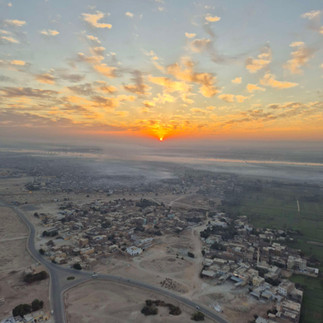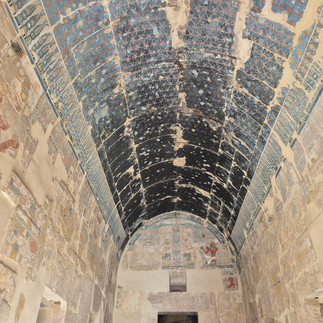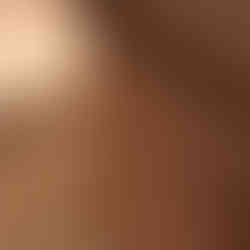Egypt 2025 Part 4 Two days in Luxor
- Anne B 10milesfrom

- Mar 16
- 9 min read
Updated: Mar 17

Another good breakfast with some very artistic food offerings, and then off to the airport. Quoits anyone?
Our flight to Luxor takes 1 hour on Air Cairo. They managed to serve a fun snack box in the time, and we just marvelled at the vastness of the arid desert below, and the occasional glimpses of the narrow life sustaining green strip alongside the Nile.
And then Luxor airport where we were met by John and our driver and whisked off to our Nile cruise boat, the Iberotel Crown Emperor. Our cabin was comfortable with a great picture window. Penny is happy as the ship has a gym and a bar, and as you all know I am thrilled there is a swimming pool. Lunch was onboard - a vast buffet, and then John reappeared for our afternoon trip to see the great Luxor East Bank temples.
Luxor was originally known as Ipet-isut meaning most sacred of places, and then for many years it was Thebes. We are into the middle kingdom of Pharoahs, so everything here is 4000 years old or younger!!
Firstly Karnak. Extending to 200 acres it is one of the largest religious temples ever built, and was added to by successive Pharoahs. Started in 2055 BC by King Sensuret I it is dedicated to 3 gods.. Amun the creator, his wife Mut divine mother and their son Khonsu, God of the moon. Their symbols are everywhere! It is complicated and hard to recognise them. For example, Amun can be represented in a hat with 2 long feathers, a rams head and/or as a rather virile gentleman!
Our guide John explained that every temple has huge gate towers called Pylons. Inside is an inner courtyard leading to the Hypostyle - a room of pillars used for religious meetings and functions. Then into the inner hall where offerings are taken, until finally you reach the inner sanctuary, usually built of granite, containing an altar, statues etc. Only the King and High priests could access this.
At Karnak everything is on a giant scale! Most of the colour has gone, but John had pictures of what archaeologists think it would have looked like. I will include these as we go through! Firstly a row of Sphinx guard the entrance.
The huge pylons lead to the inner courtyard which was huge. It is the hypostyle that took our breath away. There were 2 hypostyles here containing 134 huge columns.


Much of the roof has gone. The walls were topped with windows to let in light and air. Incredibly these are original.

Towards the top of the pillars you can see remnants of the colours that would have been everywhere. The tops of the pillars are either Lotus blossom or papyrus, the flowers of Upper and Lower Egypt.


Occasionally you see graffiti done by the archaeologists working on the excavation of Karnak, which seemed a weird contradiction! The different kings who added to the temple were represented by their carved images, statues and sphinx. One of the most interesting was King Thutmose III where whole walls were covered in drawings of soldiers with different facial features - African, Asian, eurasian each carrying a cartouche depicting the cities that he had conquered!
He also built a sacred lake here for ablutions, and next to it is the huge Kheper scarab statue dedicated to King Amenhotep.
Why is a scarab, or dung beetle, held in such high regard in Egyptian culture? It represented the cycle of life, and rebirth, against all the odds. The dung ball also was the shape of the sun, and Ra, God of the sun, was one of Egypts most important Gods. He eventually merged with Amun to create the supremely powerful Amun-Ra, God of air, fertility and Creation.
The sun god is also represented by the obelisks, 2 of which were erected by Queen Hatshepsut, pointing to the sun, and the pointed top representing the mound of creation. The top was covered in electrum, a mix of gold and silver, so they would have reflected light in all directions. This is the highest obelisk in Egypt at 97 feet tall.

As we progressed through the temple there were avenues and chambers in all directions and suddenly we would come upon huge statues, or walls of hieroglyphics or illustrations. One example is the Cachette courtyard. During its excavation in 1903 archaeologists found 700 stone statues and 17,000 bronze ones. Yes I did write that correctly. Just incredible.
The inner Sanctuary is quite bare but it does contain the original altar, and a little colour on the high wall and ceiling.

A small but special feature of Karnak is a small sphinx with the slightly damaged face of Tutankamen. He was only 19 when he died, so few statues were made for him.

Finally, these ramps were discovered and are believed to be the ones that were used to build the original walls!

Yet another remarkable place. From here we went 3kms towards the town to see Luxor Temple. This was joined to Karnak by a 3km path, lined with 1060 statues of sphinx. The first one was found in 1949, and between then and 2011, most have been excavated. There are also remnants of the old mud walls that acted as flood defences.
In front of the pylons we see the remaining obelisk, after the other one was gifted to France. Again, this is what it probably looked like! The huge pylon gate support is from a single piece of stone, and had a major crack, which was repaired using 4000 year old butterfly joints!
When Christianity came to Egypt, Emperor Constantine ordered that pagan temples be abandoned. This temple was covered in deep desert sand almost to the top of the walls, and people built houses and a mosque at what they thought was ground level! The mosque is still in use today, and you can see how high the sand was!
The courtyard and hypostyle are full of statues and pillars
And this tableau is of the papyrus and lotus flowers being tied together symbolising to union of Egypt.

This temple is dedicated to Amon as well.
The Sanctuary here was empty . This temple reflects a lot of more 'recent' history. When the Greeks ruled Egypt 2,500 years ago, Alexander the Great was King for a while and then the Ptolemies. They respected the Greek traditions and Gods and in Luxor Temple, Alexander is portrayed as a Greek. The colours in parts of this section were better preserved.
Incredibly, one section wall was painted over when the Romans were ruling Egypt about 2000 years ago, and some of their walls painting remains as well!



By now the sun was setting, so back to the ship for our extensive buffet dinner and then an early night for a very early start!
Alarm at 3.55 and then down to reception to collect our breakfast boxes and wait for our lift. We had, in a reckless moment, agreed to do a Hot air balloon ride, despite my fear of heights. Nothing on the road at 4 30am... but we got stuck behind this!

Arriving at a large area of rough ground, we were astonished to see trucks arriving from all directions with a huge basket on the back and about 8 people the back! In total there were 50 balloons. Watching them getting ready was fascinating.
The safety brief was minimal, but we took the plunge. The heat from the burners was intense. Suddenly, so smoothly, we were rising up.
There was very little wind, so movement was slow but the basket never swayed or jerked. Up over the farmland and the foothills of the desert. We watched the sun rise, and below were tombs, a few temples and the colossus of memon statues.
Farmers were starting to work in their fields running down to the Nile. At one point, nearly all the other balloons were below us which was stunning.
They peace in between the roar of the burners was heavenly, and seeing all the balloons was incredible, although how they didnt bump into each other we do not know!

We even had a fairly smooth landing in a field. The lorry and crew were there to hold it down!
What an experience. Superb. Would I do it again? Definitely. I had no vertigo at all! We had worked up an appetite so ate some of the ample breakfast box in the Ali Baba cafe, and gave the rest to some children asking for food. A quick look at Colossus of Memnon before we left.

Built in 1350BC as statues of King Amenhotep III, flanking the doors of his Mortuary temple, they are the main remaining structures, as most of the temple was destroyed by repeated Nile floods.
Next on to Queen Hatshepsut's temple. As you approach you realise just how huge this is and in such a dramatic location with the mountains behind.

The mountains were rich in bird life but I could only identify vultures and Pallid Swift. The temple itself has been restored, but the artwork and colours are original and beautiful.
Queen Hatsheput's God protector is Hathor, who takes the form of a cow, and often appears as a woman's face with cows ears and or horns . She is the Goddess of love, joy music and fertility. One side chapel is dedicated to her and the art is beautiful.
The other side chapel is to Anubis and is so beautifully decorated and with lots of original colour remaining.
They temple itself follows the usual format, and there was more colour but the sanctuary was empty.
From here we took a short drive along a very good road, twisting up into the arid mountains to reach the valley of the Kings. This road did not exist in years gone by. The only access to the Valley of the Kings was to come over the mountains on foot. The Royal families wanted their burial sites better hidden that the rather obvious Pyramid system, so they chose this remote place on the West bank where no-one else lived. People who worked on the building of the temples were housed in a special village and sworn to secrecy. As soon as a Monarch took the throne, work started to dig their tomb, and then decorate it. Consequently, some long serving rulers like Ramses II have very long, deep tombs, whereas Tutankamun's tomb is fairly near the surface and quite small. Decoration would also start while the person was alive, but some would be done afterwards, in the 70 days that the embalming process took. Archeologists have found 63 tombs, although some are simple and most had been looted in some way. They know there are more to find, like Queen Nefertiti. Tombs were well hidden once built, and because finding a site for a tomb was difficult there were many false starts which adds to the difficulty for archeologists trying to find new ones. We visited 4 tombs. All of them involved descending steeply down stairs or slopes to a final chamber where the sarcophagus would have been placed. Each one was different. The first was Ramses III, beautifully decorated, and we particularly loved the delicate hieroglyphics painted on all the tunnel walls.

The second was Rameses I and it was the deepest and largest with many decorated side rooms and ceilings. Down, down, down!

And down again



The third was Tutankamun's tomb. It was the shortest and the simplest, but the decoration in the sanctuary still remains. We had seen the coffins in the museum in Cairo, but here we saw the sarcophagus in situ with the original Sanctuary paintings around it.

Also here is his mummified body in a special container to preserve it.

These are his feet!

When Howard Carter found the tomb in 1912, it had already been disturbed, but the treasury had not been found. I love this old photo where all the contents are piled up and labelled looking like a jumble sale!

The final tomb was of Rameses IV. This was richly decorated and the sarcophagus was the largest ever found.

Incredibly there is even early Christian Graffiti / biblical quotes suggesting this was used as a place of sanctuary.
The Valley of the Kings is an incredible place. So barren in appearance, and the red sandstone reflected the day's heat (36°C, 98°F) mercilessly. I could just picture the Edwardian archeology teams here, or perhaps Agatha Christie, here with her husband, archeologist Max Mallowan. Or even Poirot himself, mopping his brow after an arduous journey across the desert! What an end to our stay in Luxor. Back to the boat for lunch, passing some almost biblical scenes on the way. We spent a lovely afternoon relaxing on deck as we set sail southwards along the Nile towards Aswan. The neighbouring boat had a very modern approach to a rear view mirror... a crew member holding it out of the window. There are many boats of all sizes, and the banks are lined with palm trees, glimpses of farmed plots and watery lagoons with birds too far away to identify!
The best and most entertaining moment came from 2 young men in a rowing boat calling up to passengers to sell pashminas and djellabas. If a transaction took place, the purchased item was put in a plastic bag and hurled, very successfully, onto the top deck from the water. Overarm. If Egypt take up cricket this lad would be great! I did manage to identify Pied Kingfishers, swallows and various egrets and Herons. (Not my photo!)

These kingfishers were all around. It was really delightful. Tea and cake was served at 4pm, and then dinner was at 7.00. One disappointment was that we were due to go through Esna Lock at around 8pm. There were so many other boats ahead of us, we were rescheduled and actually went through at 2am. Penny felt she had done enough locks when she and Pete had the barge, so didn't want to get up, and I, uncharacteristically, slept through it! So, we woke up in a new place! The next blog will be soon!







































































































































































































































Such an interesting trip.